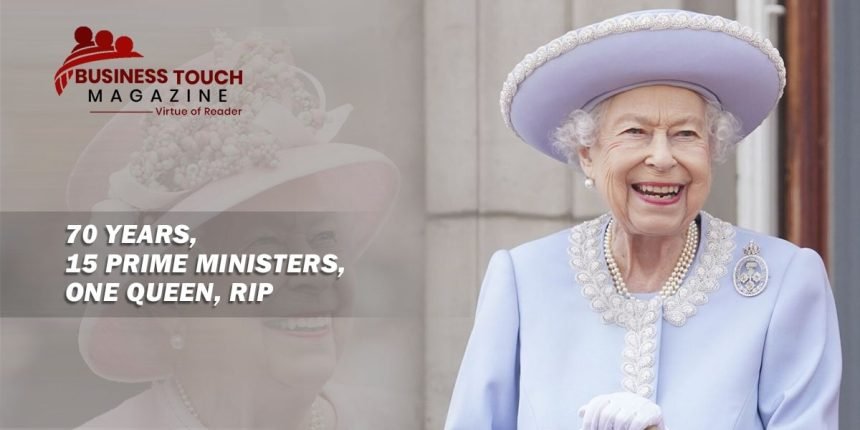After 70 years as queen, Britain’s longest-reigning monarch, Queen Elizabeth II, has passed away at the age of 96 in Balmoral.
On Thursday afternoon, at the Scottish estate she had spent the summer at, she passed away quietly.
Since her accession in 1952, Her Majesty the Queen has presided over a period of unprecedented cultural transformation.
Her son, King Charles III, expressed his “great anguish” at the demise of his mother and predicted that her passing would be “deeply felt” all throughout the globe.
The man said thusly: “We are very saddened by the loss of such a revered monarch and beloved matriarch.
“Her passing will be keenly felt by millions of people throughout the UK, the kingdoms, and the Commonwealth,” he said.
He stated that he and his family would find solace in the “respect and great love in which the Queen was so universally regarded” throughout the approaching time of sorrow.
According to Buckingham Palace, the King and his wife, Camilla, the new Queen Consort, will return to London on Friday. On Friday, he will reportedly give a speech to the country.
Since the Queen’s physicians had expressed worry about her health earlier in the day, the senior royals had assembled in Balmoral.
When the Queen’s health required medical attention, her children all made the trip to Balmoral, which is not far from Aberdeen.
Prince William, her grandson and the heir to the throne, was present, as was his brother, Prince Harry.
Newly appointed Prime Minister Liz Truss praised the queen on Tuesday, saying that she had “given us with the stability and strength that we needed.” The Queen appointed Truss to her position.
Concerning the future monarch, she remarked: “We pledge our undying support to him, just as his mother did for so many years.
Exactly as Her Majesty would have wanted, we shout “God save the King” to mark the end of the second Elizabethan period and the beginning of a new chapter in the glorious history of our great nation.
Justin Welby, Archbishop of Canterbury, expressed his “deep regret” at the passing of Queen Elizabeth II, who is the head of the Anglican Church in England.
The King and the Royal Family are in my thoughts and prayers,” he stated.
During her reign, Queen Elizabeth II oversaw the United Kingdom during times of postwar austerity, the changeover from empire to Commonwealth, the end of the Cold War, and the United Kingdom’s accession into and subsequent exit from the European Union.
She had 15 prime ministers throughout her time in office, beginning with Winston Churchill in 1874 and ending with Ms. Truss in 1975, a period of 101 years.
Throughout her reign, she often met with her prime minister for audience.
Cries were heard from the masses waiting outside Buckingham Palace in London for news of the Queen’s health when they learned of her passing.
At 18:30 BST, a formal notice announcing the death was put outside the palace, and the union flag was lowered to half-staff.
After the passing of the Queen, Prince William and his wife Catherine assumed the titles of Duke and Duchess of Cambridge and Cornwall.
Elizabeth Alexandra Mary Windsor entered the world on April 21, 1926, in Mayfair, London.
No one expected Elizabeth to become king when her uncle, Edward VIII, abdicated in December 1936 to wed the twice-divorced American Wallis Simpson.
At the age of 10, Elizabeth, or Lilibet as she was called in the family, became the successor to the throne upon the death of her father, King George VI.
Three years later, Britain was at war with Nazi Germany. After their parents refused to have them evacuated to Canada, Elizabeth and her younger sister, Princess Margaret, spent the most of the war at Windsor Castle.
When Elizabeth turned 18, she enlisted in the Auxiliary Territorial Service, where she stayed for five months, learning the fundamentals of auto repair and driving. The experience helped her “understand the esprit de corps that grows in the face of hardship,” she said of it afterwards.
She kept in touch with her third-cousin-once-removed, Philip, Prince of Greece, who was serving in the Royal Navy, through letters during the war. Following a successful courtship, the pair wed on November 20, 1947, in Westminster Abbey, with the prince becoming the Duke of Edinburgh.
When he died in 2021 at the age of 99, she referred to him as “my strength and stay” throughout their 74 years of marriage.
The couple had four children: Charles in 1948, Anne in 1950, Andrew in 1960, and Edward in 1964. They provided their parents with 12 great-grandchildren and eight grandkids between them.
In 1952, when representing an ill King in Kenya, Philip informed Princess Elizabeth that her father had passed away. After being crowned, she quickly went to London.
She reflected on the experience, saying, “It was all a very sudden type of taking on and doing the best job you can.”
On June 2, 1953, at the age of 27, Elizabeth was crowned in Westminster Abbey in front of a then-record television viewership of more than 20 million people.
The following decades would usher in radical shifts, with the demise of the British Empire abroad and the widespread rejection of traditional values by the Swinging ’60s generation at home.
Queen Elizabeth updated the monarchy for a less formal era by doing walkabouts, visiting schools, and attending community activities.
She never wavered in her dedication to the Commonwealth, making at least one trip to each member nation.
Although there were times of both internal and external suffering.
The fire that ravaged Windsor Castle in 1992, the Queen’s “annus horribilis,” was also the year that three of her children’s marriages ended in divorce.
The Queen was criticized for her lack of public response after the 1997 automobile accident that killed Diana, Princess of Wales, in Paris.
The value of a monarchy in today’s culture has been called into doubt.
She conceded that, “no organization… could expect to be exempt from the examination of those who give it their allegiance and support, not to mention those who don’t.”




